Quality of the Environment in Japan 1995
4. Damages to Fisheries
Types of damage that the fishing industry is suffering from due to water pollution include:1) deterioration of fishing environment and damages to boats and equipment due to floating objects on surface water, deposits, etc..; 2) destruction or incomplete development of marine organisms due to oil contamination and red tides; 3) unsalable fish or decreased fish prices due to accumulation or adhesion of hazard-ous substances such as heavy metals, PCBs, etc ; and 4) soiled or rotten boats and equipment due to oil contamination, etc.
According to the reports from prefectures 176 cases of un-expected damages to fisheries occurred in 1993 (233 cases in 1992) due to water pollution, the total amount of damages was 2,479,530,000 yen (701,860,000 yen in 1992). As compared to 1992, the number of occur-rences has decreased, but the total amount of damages has increased drastically. Among these, the damages caused by oil contamination of the sea was 39 cases, 1,166,690,000 yen (58 cases, 190,870,000 yen in 1992), damages caused by red tides was 31 cases, 338400,000, yen (31 cases, 628 441,800,000 yen in 1992).
Concerning fish and shellfish contaminated by mercury, PCBs, etc., in nine water areas where contamination by mercury has been found, one area where PCBs were found, and six areas where insecti-cides of the drins were found, voluntarily restricted fishing has been continuously encouraged and eating guidance has been provided (as of the end of December 1994).
5. Other Damages
According to the result of the water quality survey for beaches conducted in 1994 by the Environment Agency, all 396 beaches examined maintained an adequate level of water quality for bathing. However, there were two beaches which should take some measures to reduce the number of coliform groups.
Section3. Measures for Water Pollution Control
1. Establishment of Environmental Quality Standards
Environmental quality standards concerning water pollution are set as targeted levels of water quality in public water areas, and they should be achieved and maintained. The standards are classified in two categories the levels to be achieved and maintained to protect human health, and the levels to be achieved and maintained to preserve the living environment.
In the health category, uniform standards are set for public water areas while in the living environment category, standards are set for each classified type of water area depending on the purpose of usage of the water area. According to the type of area designated, a specific standard can be applied.
The environmental quality standards concerning the protection of human health were revised, substantially in March 1993. The stan-dards currently specify 23 items including heavy metals such as cad-mium, lead, etc.; organochlorine compounds such as trichloroethylene, .etc.; and agricultural chemicals such as simazine, etc. In addition to these, the standards were set as guideline levels for items that require close monitoring, in order to better understand the condition of water quality and further promote the prevention of water pollution.
For items of the living environment category, standards per BOD, COD, and DO are specified. In order to prevent eutroppication, stan-dards for nitrogen and phosphorus have been newly set for coastal areas in August 1993, in addition to the standards for lakes.
If the use of a water, area has been changed after the classifica-tion of type of area has been completed, the classification is to be reviewed systematically.
Concerning the removal of the bottom sediment containing haz-ardous substances, provisional removal standards are established for bottom sediment containing mercury or PCBs.
2. Tightening of Restrictions on Effluents
(1) Expansion of restriction items and tightening of standards
In an effort to preserve the water quality in public water areas, the Water Pollution Control Law sets nationally uniform standards for effluent discharged from specified factories into public water areas.
Some standards set for hazardous substances have been added to these nationally uniform standards, and some have been tightened, in conformity with the environmental standards concerning human health which were expanded and tightened in March 1993. New standards have been set for seven items of organochlorine compounds including dichlor-omethane, etc., and 13 items of agricultural chemicals including sim-azine, etc., and standards for lead, arsenic, etc. have been tightened. These new or tightened standards have been enforced as of 1 February 1994. Table 8-3-1 shows the revised standards for effluent concerning hazardous substances.
In order to preserve the environment of sea areas by controlling eutrophication in closed sea areas such as inner bays, inner seas, etc., effluent standards have been established for nitrogen and phosphorus, and enforced as of 1 October 1993 (see 4 in Section 4).
(2) Establishment of more strict standards for effluent
For those areas in which the environmental quality standards can not be met or maintained only by satisfying the nationally uniform effluent standards, prefectures can establish, by ordinances, more strict standards in addition to the national standards. These stringent stan-dards have been established in all prefectures since 1975.
Table 8-3-1 Effluent Standards concerning Hazardous Substances
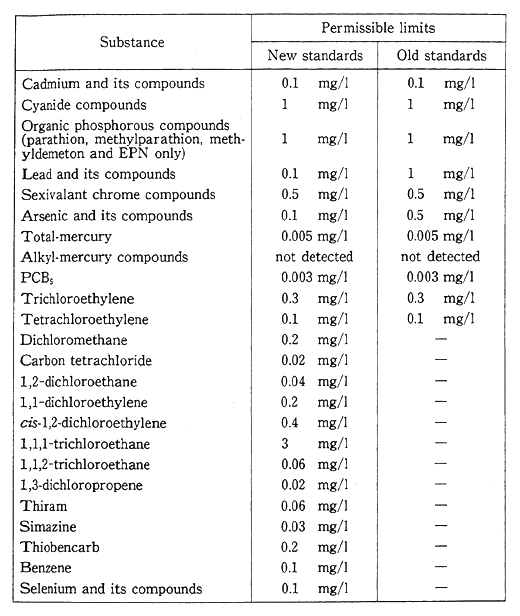
(3) Expansion of types of businesses subject to restrictions
The Water Pollution Control Law was applied to approximately 500 types of industries out of approximately 1,100 types, the total number of types of industries according to the detailed classification by the Japan Standard Industry Classification System, when the law was first enforced in 1971. Ever since, new types of industries have been added every time the law was revised, and currently approximately 600 types of industries are subject to the law. In addition, a system called the "Specified Facilities in Designated Areas" has been established within the areas where the total amount of effluent is restricted, and the system is applied to sewage treatment equipment capable of handling the human waste of 201 500 people.
(4) Investigations on non-restricted items
Investigations on water quality were conducted in nationwide areas where might be polluted by organotin compounds (TBT, TPT). Another investigation was conducted to study the impact of deteriora-tion of the marine environment, such as impact of lowered degree of clarity on marine life. Concerning warm effluent, the intermediate report on the issue of warm effluent was submitted by the Sub-committee on Warm Effluent, Water Quality Committee of Central Council for Pollution Control in 1975.
(5) Measures to preserve water quality at sources of city water
Corresponding with people's increased concern in the quality of city water, the "Basic Policies of Preservation of Water Quality in the Sources of City Water to Prevent Problems in Specified City Water and Irrigation Systems" was decided upon by the Cabinet in May 1994, in conformity with the Law Concerning the Special Measures for the Protection of Water Quality in Water Resources Area for the Purpose of Preventing Specific Trouble Drinking Water Supply (referred to as the "Special Measures Law" hereafter) which was established in Febru-ary 1994.. In December 1994, the Central Environment Council was inquired about the establishment of a range for specified effluent stan-dards concerning the formation of trihalomethane, in consideration with the results from the effluent fact-finding investigations.
In conformity with the Law Concerning the Promotion of Pro-jects to Preserve Water Quality in Drinking Water which was estab-lished at the same time as the Special Measures Law, requests were made by the end of 1994, by seven city water system operators from four prefectures for the concerned prefectures to promote the enforcement of the project for preservation of raw water quality used in city water systems. As a result of these requests, prefectural plans for the project have been determined for three operators of city water systems in two prefectures, and determination of other plans are under way for four operators in three prefectures, as of the end of March 1994.
(6) Measures for water pollution accidents
In June 1989, the Water Pollution Control Law was partially revised. It now specifies that, in case of a water pollution accident, the owner of the facility concerned is to take emergency measures, and that the facility owner is to notify the governor of the concerned prefecture of the measures taken.
3. Promotion of Measures for Domestic Effluents
One of the problems that are contributing to water pollution in public water areas is effluent associated with daily living such as cooking, laundry, bathing, etc.
In order to promote the measures to control domestic effluent it is important to improve not only sewerage systems but also various other drainage treatment facilities such as community plants, drainage facilities for agricultural communities, individual treatment equipment of mixed-effluent etc., according to the actual condition of each area. At the same time, measures such as increasing people's awareness toward the issue, encouraging people to participate in activities to reduce domestic effluent, should be promoted as well.
The Environment Agency formulated the "Guideline for Guid-ance on the Promotion of Measures to Cope with Domestic Effluents" in 1988, and holds a Water Environment Forum every year as part of measures. By the partial amendments made to the Water Pollution Control Law in June 1990, stipulations on measures for domestic efflu-ent such as (i) clarification of responsibilities to be assumed by the administration and the people concerning domestic effluent; and (ii) systematic promotion of measures for domestic effluent, have been improved According to the revised Water Pollution Control Law, governors of prefectures are working on the designation of the areas for which intensive measures should be taken. Fifty municipalities located at 18 areas in 13 prefectures have been newly designated in 1994, and 369 municipalities at 132 areas in 40 prefectures have been designated as of 31 March 1995. Support was provided toward these designated munici-palities for their determination of a "Program for the Promotion of Measures Against Household Effluents", establishment of facilities to purify water channels severely polluted by household effluent, develop-ment of facilities for collection of used oil and making soap from it and so on.
In an effort to preserve the living environment and to help conserve the water quality of public water areas, the Ministry of Health and Welfare and the Ministry of Construction designate the day of 10 September as "Sewage Promotion Day," and the Environment Agency, the Ministry of Health and Welfare, and the Ministry of Construction jointly designate the day of 1 October as "Septic Tank Promotion Day."
4. Improvement of Sewerage System
To support healthy growth of a city, improve public hygiene, ensure a good living environment, and to preserve the quality of public water areas, sewerage systems are vital and fundamental facilities.
Currently, a systematic project to improve sewerage systems is under way according to the Seventh Five-year Sewerage System Devel-opment Program, which was initiated in the fiscal year 1 991. One of the major objectives of this project is to improve sewerage systems, using its project budget of 16,500 billion yen, in middle-and small-sized municipalities, where the provision of sewerage systems are significant-ly behind. Another key objective of this project is to promote sewerage system operations as well as their high-grade treatment technologies to meet the requirements of the Regional Environmental Pollution Control Program, the Program for Reduction is Areawide Total Pollutant Load Controls in closed water areas, and the Water Quality Conservation Plan for Lakes and Reservoirs. Moreover, it is also aiming at the achievement of the water environmental quality standards ; prevention of flood and improvement of the living environment in urban areas, conservation of the natural environment in lakes and reservoirs; improvement of the living environment in agricultural communities, mountain villages, and fishing communities; and promotion of effective use of treated sewage water and sludge. Table 8 3 2 shows the break-down of the project budget.
In 1994, which is the fourth year of this program, the following measures were taken to improve sewerage systems:
(1) Sewerage system operations
In the fiscal year 1994, various projects to develop sewerage systems were conducted using the total project budget of 3,014.7 billion yen (initial budget). These projects include : public sewerage systems in 1,311 locations ; watershed sewerage systems in 119 locations; sewer-age channels in urban areas in 307 locations; specified public sewerage systems in two locations ; and specified public sewerage systems for environmental preservation in 614 locations. As a result of these improvement projects, the treatment capacity keeps increasing by 'two million people every year. The ratio of treatment capacity against the total population is expected to be approximately 51% by the end of the fiscal year 1994.
Table 8-3-2 Project Expenditures under the 7th Five-year Sewerage System Development Program by Project
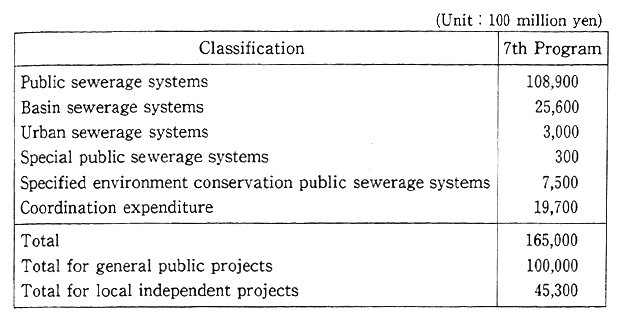
Note: Based on data from the Ministry of Construction
For those areas in which drastic improvement is needed, the "Specified Project for Emergency Improvement of Sewerage System," a project to promote improvement of sewerage systems by fully utilizing projects that are operated independently by the local government, in conjunction with the projects supported by the Government, has been enforced.
From the standpoint of the effect that the improved sewerage systems can produce in conservation of water quality in public water areas, a concept called the "Come Back Aquatopia" has been developed and promoted in 34 cities, which objective is to foster the relation between the residents and the clear water in the community. And in addition to the measures for controlling domestic effluent which have been enforced on days with fine weather, a program called the "Model Project for Measures for Purification of Drainage from Urban Areas", a project aiming at collecting and treating polluted urban runoff, has been established.
In an effort to revive small streams in urban areas in response to people's need for a peaceful and pleasing urban living environment, various projects are being carried out. These include: sewerage system model project of sewerage systen with amenities being carried out in five locations, a sewerage system utilizing treated sewage water ; recy-cled water sewerage system projects in 13 locations (two new projects), a system utilizing treated sewage water for flush toilets in urban areas where demand for water is pressed; sewerage system with improved appearance model projects (the Watersquare Plan) in 44 locations (14 new projects), a project aiming at improving the appearance of sewer-age facilities by planting trees and creating promenades around rain-water ditches in urban areas ; and sludge recycling model projects, whose objective is to promote the utilization of sludge generated in sewage treatment processes for construction purposes, by aggressively using the sludge products in construction projects of sewerage systems. Also a project called the Future Sewerage System in Urban Areas Model Project was started in Tokyo Metropolis and Kobe City. The objective of this project is to develop a sewerage system that can provide diverse service functions for urban life by actively utilizing added values of the sewerage system facilities such as the space around facilities, treated water, sludge, etc., and the project also aims at promoting a strategic urban development utilizing these functions provided by the sewerage facilities. Additionally, the Sewerage System Project to Cope with Snow which is aiming at maintaining city functions during winter in areas with heavy snow fall, was implemented in ten cities, and the Aqua Park Model Project, a project to promote incorpor-ative development of sewerage and park facilities, was implemented in seven locations.
(2) Comprehensive sewerage system development program by watershed
In order to determine the comprehensive sewerage development program by watershed, which is a basic plan for the sewerage develop-ment works necessary to achieve and maintain the environmental quality standards set for public water areas, investigations were con-ducted in 193 locations in the fiscal year 1993, and in seven locations including the Osaka Bay area in the fiscal year 1994.
The comprehensive sewerage development program by water-shed related to 83 areas were determined by 1994.
(3) Development of technologies, research and study, etc.
In an attempt to help promote sewerage projects smoothly, studies on various issues were conducted. These issues include the basic policies of the sewerage development program and its rationaliza-tion ; design and construction methods of sewerage facilities ; rationali-zation and raising efficiency of sewerage technologies treatment and disposal methods of sludge generated from sewage treatment ; technol-ogy for small-scale sewerage systems; upgrading of treatment facil-ities, the environment of treated water, and utilization of treated water : measures for rain water from a standpoint of sewerage system management ; collection and utilization methods of energy resources generated in sewerage systems ; improvement of durability of sewerage facilities ; sewerage technologies to cope with environmental changes; measures for the diversified role of sewerage systems; and mainte-nance and justification of sewerage systems. Also, in order to improve sewerage technologies and efficiency of operation, application of new technologies model projects, in which various new technologies and construction methods are actively introduced, are being carried out.
A "Sewerage Technology Development Five-year Program" has been determined with the objective to aggressively develop major tech-nologies focusing on the 21st century, while valuing the conventional technologies that have supported the sewerage systems of today.
(4) Japan Sewerage Works Agency
Japan Sewerage Works Agency carried out construction of termi-nal treatment facilities per the request of local governments, as well as training of sewerage engineers, technical certification of sewerage engineers, research and development, and experiment of sewerage technologies, and studies on the evaluation of new technologies.
In the fiscal year 1994, the "Inter-regional Project for Sewage Sludge Treatment " (Ace Plan) which was established in 1986, was enforced, funded by the Fiscal Investment and Loan Program, in the Hyogo area (East Block and West Block), the Osaka Northeast area, and the Osaka South area.
5. Development of Monitoring System
(1) Monitoring of water quality in public water areas
In the fiscal year 1994, the Environment Agency continuously provided financial aid toward the expenses for the determination of monitoring plans, and expenses concerning the surveys of water quality in public water areas, out of all expenses necessary to execute constant monitoring of the water quality in public water areas, in accordance with the Water Pollution Control Law. The monitoring is to be conduct-ed in the areas where the necessity of the water quality monitoring is high, such as the areas that have been designated to be applicable for the environmental quality standards.
The Ministry of Construction, as the administrator of rivers, conducted examinations of water quality of major class-i rivers nation-wide to grasp the state of pollution.
In order to strengthen the monitoring system of water quality in public water areas, it is necessary to promote the automation of monitoring at certain points where intensive monitoring is needed. As of the end of 1994, automatic water quality monitoring devices have been set up in 165 locations by prefectures and administrative ordinance-designated cities, with the aid from the Environment Agency. The Ministry of Construction, as the administrator of rivers, has also set automatic water quality monitoring devices on 139 points in 66 class-i rivers nationwide. Telemetric devices are used in 127 locations among these, in order to execute centralized monitoring.
Currently, measurements taken by automatic water quality monitoring devices are approved as an official measurement method for the environmental quality standards concerning pH and DO. Investiga-tions have been conducted to study the possible official approval of measurements by automatic water quality monitoring devices for COD as well.
The Environment Agency provided financial support toward local pollution research centers, etc. for their purchase of water quality analyzers, in an effort to enhance the monitoring systems of prefectures and administrative ordinance-designated cities. Moreover, in the fiscal year 1994, the Environment Agency and the Ministry of Construction jointly conducted a survey of water quality of rivers using organisms living in the water as indexes. Approximately 45,000 people participated in the survey under guidance of the environmental departments of prefectures, and approximately 12,000 people under guidance of the offices of river-related projects under the local government's construc-tion department (the fiscal year 1994).
(2) Monitoring of effuluents
In order to monitor the status of conformity to the effluent standards, the governors of prefectures or the mayors of administrative ordinance-designated cities demand factories or workshops for perti-nent reports, or make on-the-spot inspections as necessary, in accor-dance with the Water Pollution Control Law. Depending on the results of these monitoring activities, the governors of prefectures or mayors of administrative ordinance-designated cities take necessary administra-tive measures, such as orders for improvement against factories and workshops. Support is provided by the Environment Agency for neces-sary expenses.
The Environment Agency also provided support toward the concerned local governments for their development of telemetric water quality monitoring systems.
6. Measures for Purification
(1) Measures for purification of rivers, etc.
As measures for purifying rivers, various projects have been conducted under the name of "River Environment Development Pro-gram (River Purification Program)," in 96 areas (35 areas in direct control, 61 areas in auxiliary control) with the total project budget of 21,385,700,000 yen. These projects include: the purification water induction project, in which the condition of a polluted river with a low flow rate is improved by mixing in the purification-purpose water induced from a large river (Shin-arata River, Uchi River, etc.) ; the direct purification project, in which heavily polluted river water is purified by the gravel contact oxidation method (Edogawa River, etc.); and the sludge dredging project, where the bed of a river containing large amount of accumulated organic matter is dredged to reduce the sources of offensive odors and pollution (Kasumigaura, Nakaumi, etc.).
In five heavily polluted rivers in the three major city areas, the "Program of Comprehensive Purification Measures for Specified Rivers" (project budget 732 million yen) in which purification is perfor-med in the basin of the river, was conducted, in addition to the conven-tional purification project performed in certain parts of the river. Also conducted was the "Lake Town Development Program," a project aiming at executing the operation of dredging sludge from a lake or reservoir and the environmental development around the lake or reser-voir at the same time as one comprehensive project.
As measures to control turbid water and eutrophication in dam reservoirs, the "Project to Conserve Water Quality of Darn Reservoirs," in which aeration is performed, was conducted in 17 dams (including three new projects) with a total project budget of 3,758,200,000 yen, and also the "Development Program of the Watershed of the Specified Reservoirs," in which the removal of nutrient salts is performed in watersheds, was conducted in four dams (two new projects) with the project budget of 156 million yen.
(2) Improvement of river flow conditions
The conditions of river flow in Japan fluctuate substantially throughout a year. When flooded, a massive amount of water flows down a river in a short period of time necessitating flood control measures, and in dry seasons, measures to control water usage and for the conservation of water quality are required. To cope with this, multi-purpose dams have been constructed in order to maintain and improve the proper functions of river flow, and also the induction of purification-purpose water per the river flow adjustment project, is carried out at the same time.
There were 351 completed dam construction projects under the jurisdiction of the Ministry of Construction by the end of March 1994. A total of 299 projects including the "Dam Project as the Measures to Control the Water Environment", a project aiming to ensure the water for environmental use such as purification-purpose water, were enforced in the fiscal year 1994. Efforts were made to enhance the abundant water environment by actively improving the condition of river flow, to stabilize the amount of water taken in from rivers, and to preserve the water quality of rivers.
(3) Measures for purification of coastal areas
In an effort to revitalize the productivity of coastal or inner water fishing grounds, of which the productivity has been lowered due to the accumulated floating matter such as waste, etc., support was provided for the implementation of fishing ground clean-up projects (53 locations) conducted by prefectures. As part of the "Coastal Fishing Ground Development Projects", support was provided for restoration projects (50 locations) such as dredging, plowing, channeling, etc. for fishing grounds of which the productivity has been lowered due to deterioration of the quality of water or the sea bed. The projects for purification of sea areas were carried out in four beaches including Fujisawa beach in order to remove sludge from heavily polluted sea areas.
(4) Measures for removal of bottom sediments polluted by mercury or PCBs
As for the pollution of bottom sediments by mercury, there were 42 areas of which the levels of pollution of bottom sediments exceeded the provisional removal standards, requiring some measures such as removal of bottom sediment. As of the end of July 1990, measures for these areas have been completed. There was one area of which the bed was polluted by a natural factor.
As for the pollution of bottom sediments by PCBs, investigations revealed that there were 79 areas nationwide which require measures such as removal of the bottom sediments. The measures have been completed for 75 areas as of the end of March 1993. Measures such as removal of bottom sediments are under way or being discussed for the other four areas including the Sasebo Harbor (Sasebo City).
(5) Measures for purification of waterways
Within the areas that have been specified per the Water Pollution Control Law as the areas requiring extensive measures against domes-tic effluent there are a number of areas where development of domestic effluent treatment facilities such as sewerage systems, etc. is not expect-ed to be constructed in the near future, despite the fact that the pollution in the area caused by domestic effluent is substantial and measures should be taken immediately to preserve the living environment. To resolve this problem, the Environment Agency has been enforcing the "Projects for Installation of Purifying Facilities of Waterways Polluted by Domestic Effluents" since the fiscal year 1992. This project is to execute a purification process directly to the polluted waterways and small streams which do not fall under the categories of "rivers" in the River Law, or "city sewage waterways" in the Sewerage Law. The projects were enforced in 15 prefectures, 18 municipalities in the fiscal year 1994, with the total budget of 952.49 million yen with the Govern-ment's subsidy of 300 million yen.
In areas outside the areas that have been designated as the areas requiring extensive measures against domestic effuent, waterway pur-ifying projects that are established independently by each municipality have been implemented.
7. Measures for Controlling Water Pollution concerning Agriculture, Forestry and Fisheries
(1) Measures against pollution of agricultural water
Actual conditions of the water quality of agricultural purpose drainage were studied from a standpoint of the conservation of the quality of agricultural water. At the same time, investigations of the state of water quality and causes of pollution were conducted for large-scale sources of agricultural water of which the pollution levels are concerned. A fact-finding survey on agricultural damages caused by water pollution was also carried out. Moreover, studies to establish methods of improving the water quality of agricultural water was conducted.
In areas where agriculture is promoted, the project for drainage from agricultural communities, which is a program with the objective to develop water treatment facilities for the drainage from agricultural communities, was conducted in 1,507 areas. For the areas where emer-gency measures for the control of damages are needed, projects concern-ing the measures for water quality problems such as the separation of drainage from service waterways, the switching of water sources, etc. were conducted in three areas under direct maragement, and 61 areas with subsidies.
In addition, purification waterways utilizing the natural purifying ability of ditch reeds or charcoal were developed, and the project for the preservation of water quality in agricultural communities, whose objec-tive is to improve the water quality of agricultural drainage flowing into the public water areas such as lakes and reservoirs, was conducted in six areas.
(2) Measures for pollution prevention of fisheries
1) Investigations on pollution affecting fisheries
Various investigations were conducted concerning the pollution affectiflg the fisheries. These include: an investigation of the state of pollution in fish and shellfish caused by hazardous chemical substances such as mercury, PCBs, dioxins, etc. ; an investigation of early detection methods of pollution in fish and shellfish caused by new pollutants and its measures ; an investigation to establish test methods for short-term toxicity of hazardous chemicals using marine fish ; an investigation to resolve the pollution mechanisms in fish and shellfish caused by hazard-ous chemicals; and an investigation of the impact of acidification of lakes and reservoirs by acid deposition, on inner water fisheries. Also, measures for shellfish poisoning such as the development of prediction methods of poisoning of shellfish, etc., were taken.
Studies on the impact of large quantity intake or discharge of water by power stations located in inner bay areas of shallow sea areas were carried out as well.
The monitoring of the marine environment was carried out on a global basis utilizing Japanese fishing boats.
2) The prevention of fishery pollution and the development of a guidance system
Various kinds of activities were carried out in order to prevent or reduce the pollution affecting fisheries. These activities include : the monitoring of fishing grounds and guidance for fishermen by fishery pollution investigators of each prefecture; providing support for the project for conservation of fishing grounds, a project that promotes the installation of oil pollution prevention equipment, observation equip-ment, etc. ; providing support for the development of new methods to conserve the ecosystem and the productivity of fishing grounds in the coastal areas of Okinawa Prefecture ; and activities to enlighten people by means of movies, television, etc. about the state of pollution affecting fisheries, measures to prevent pollution, etc. Support was given to fishing ground cleanup projects which are enforced by prefectures. Support was provided also to fishermen's associations for the develop-ment of a disposal plan of fishery waste, such as FRP fishing boats, fishing nets, shells, etc.
3) Measures for the prevention of red tides
As part of the measures for the control of the occurrence and the damages of red tides, support was provided for the "Project to Monitor Red Tides and Shellfish Poisoning", of which the objective is to collect information on the state of generation of plankton which cause red tides, and to enable the exchange of information and communication among the concerned parties. The development of technologies to resolve the generation mechanisms of different types of red tides and to prevent damages in fisheries, was conducted. Also carried out was a project for the development of the red tides generation prediction system which employs a data base of information related to red tides and its network system. Additionally, the development of the technol-ogies to prevent the generation and damages of the mass of water lacking oxygen (blue tides) was carried out. And studies on the methods to resolve the elution mechanism of pollutant from the bed of water, and to improve the quality of the bed of water were carried out as well.
4) Measures for water purification of fishing ports
In order to purify the water of fishing ports and the surrounding water areas by properly treating the drain water from fishing commu-nities, the project to improve drainage from fishing communities was conducted in 101 areas.
(3) Measures to relieve damages
In order to deal with oil pollution accidents of which the parties who caused them are unknown, support was provided for the relief programs carried out by the Fund for Oil Pollution Damage to Fishing Grounds. Aid was given to part of the net premiums for the mutual aid concerning the special contract on red tides in the mutual aid agreement for the aquaculture industry.
Section4. Measures to Conserve Water Quality of Enclosed Water Bodies
For bays, inland seas, lakes and reservoirs and other enclosed water bodies particularly with significant pollution sources in the hinterland, the rates of achieving environmental quality standards are lower than for other areas, because the loads of pollutants are signifi-cant and pollutants tend to accumulate. In, addition, the inflow of nitrogen, phosphorus and other chemicals leads to the progress of so called eutrophication.
The achievement of the environmental quality standards of COD, a typical index of organic pollution, in enclosed water areas such as the Tokyo Bay, the Ise Bay, the Osaka Bay in the Seto Inland Sea, etc. was still low in 1993. The achievement rate of lakes and reservoirs was especially low with 46.1% (Figures 1-1-20 and 1-1-21).
A check of the generation of red tides indicates that there were 42 cases in Tokyo Bay, 37 cases in Ise Bay in 1993, and 94 cases in the Seto Inland Sea in 1994, and in Tokyo Bay and other bays, the genera-tion of blue tides is observed. There are now a few lakes and reservoirs where the generation of blue-bloom and freshwater red tides is obser-ved. Given this situation, there is the need to further strengthen mea-sures for the conservation of the water quality of closed waters.
1. Promotion of Areawide Total Pollutant Load Control
To improve the water quality of vast closed water areas, it is necessary to reduce total amount of pollutants flowing into the waters.
With the Water Pollution Control Law revision of 1978, areawide total water pollutant load controls were institutionalized for overall reduction in the loads of pollutants flowing into waters. This system is enforced for Tokyo Bay, Ise Bay and the Seto Inland Sea with COD taken up as a designated item.
The first series of areawide total pollutant load controls (with the target year set at 1984) and the second series of areawide total pollutant load controls (with the target year set at 1989) were carried out, but it was still necessary to improve the water quality of these waters. Therefore, the third series of areawide total pollutant load controls (with the target year set at 1994) was carried out in accordance with the Basic Policy for Areawide Total Pollutant Load Controls (formulated in January 1991) and the Program for Reduction in Areawide Total Pollutant Load Control (formulated in March 1991).
The third series of areawide total pollutant load controls spec-ifies the reduction targets of loads at target year by source (industry, household, and other). The target is. to reduce 13% in the Tokyo Bay, 8% in the Ise Bay, 9% in the Seto Inland Sea, and 10% for the entire three areas (from 1989) by the target year. The reduction targets by source are 12% from domestic sources, 9% from industrial sources, and 2% from other sources (Figure 8-4-1). To achieve these targets, the improvement of sewage systems has been promoted and other compre-hensive measures depending on the circumstances of each area have been taken. These measures include: measures for domestic effuluents such as development of community plants, drainage facilities for agri-cultural communities, combined-purpose septic tanks, etc. measures for industrial effluent, such as Effluent Standard for Areawide Total Pollutant Load Control, etc.; and so on.
The procedures for improving water quality of those areas are under study with surveying the enforcement of third series of areawide total pollutant load controls.
Current situations of the closed waters need further Program for Reductions in Areawide Total Pollutant Load Control. These programs are now under the review.
Fig. 8-4-1 Total Pollutant Loads and Reduction Targets for Three Sea Areas under Areawide Total Pollutant Load Control by Source
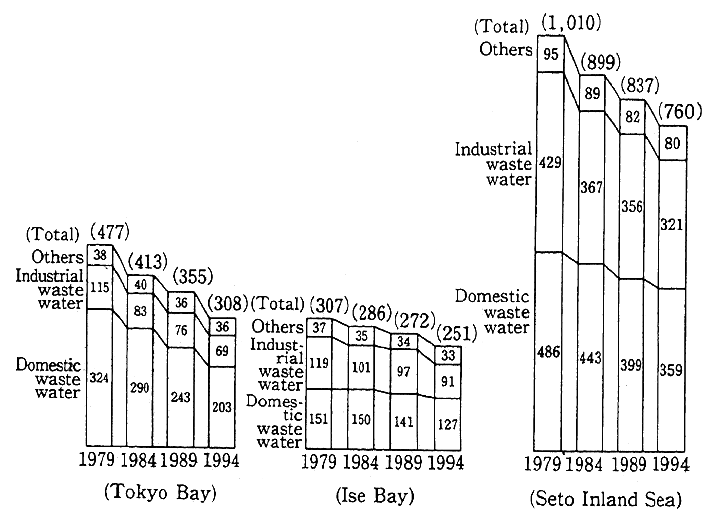
Remarks : Actual figures for FY 1979, 1984, and 1989, reduction target figures for FY1994 (Unit : tona/day)
2. Measures for Environmental Conservation of Lakes and Reservoirs
Since lakes and reservoirs are enclosed water bodies pollutants tend to accumulate easily ; thus the achievement status of the environ-mental quality standards is lower than that of rivers and sea areas. Eutrophication in these areas is creating various problems in irrigation systems. Since it was recognized that the application of the restrictions per the Water Pollution Control Law alone could not improve the water quality of lakes and reservoirs sufficiently, the Law Conconing Special Measures for Conservation of Lake Water Quality was established and enforced as of March 1985. Under this law, lakes and reservoirs that need immediate measures to meet the environmental quality standard are to be designated, and the Water Quality Conservation Plan for Lakes and Reservoirs is to be determined for those lakes and reservoirs so that various measures can be taken comprehensively and systemat-ically. These measures include ; projects for conservation of water quality, such as development of sewerage systems, etc. ; restrictions against sources of pollutants and preservation of the natural environ-ment around lakes and reservoirs. There are ten lakes and reservoirs that have been designated as above including Lake Nojiri which was newly designated in October 1994. Table 8-4-1 shows the summary of this plan. The second-term Water Quality Conservation Plan for Lakes and Reservoirs which includes measures for nitrogen and phosphorus has been determined for five areas including Lake Biwa, Kasumigaura, etc. in March 1992, in Kamafusa Dam Reservoir and Lake Suwa in March 1993, and in Nakaumi and Lake Shinji in March 1995.
3. Measures for Eutrophication
Eutrophication originally referred to the phenomenon in which the water of lakes is gradually fertilized by nutrient salts such as nitrogen, phosphorus, etc. that are supplied from its watershed. How-ever, due to the centralization of population and industries in recent years, nutrients are flowing into sea areas such as inner bay areas, in addition to the lakes and reservoirs. Overflow of these nutrients causes the bloom of algae, thus the water quality is deteriorated progressively, causing serious environmental problems.
Table 8-4-1 Summary of Water Quality Conservation Plan for Lakes and Reservoirs
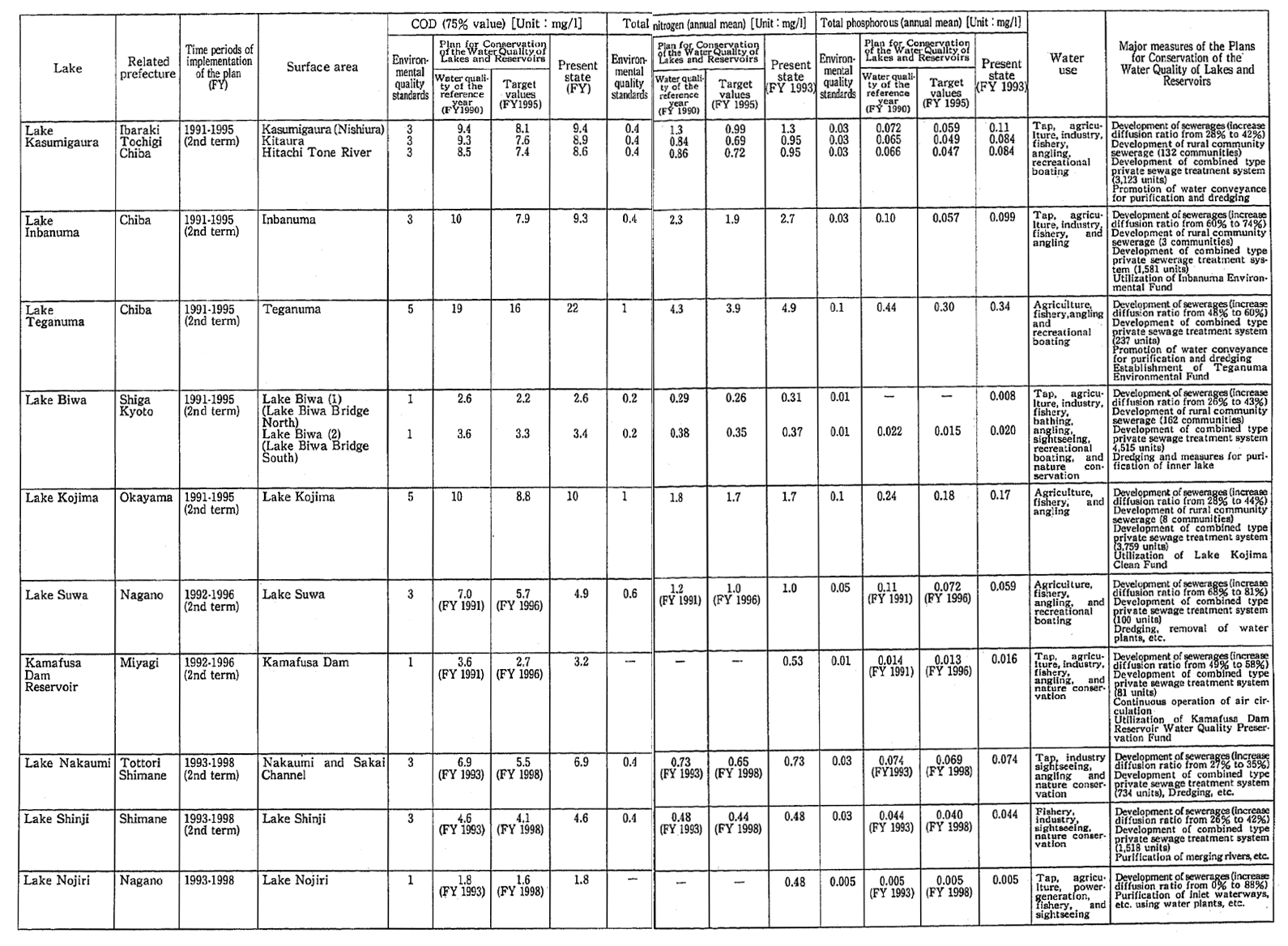
* "Water Quality of the Reference Year" means the water quality measured in the is used for a comparison with the targeted water quality.
* When there are multiple monitoring points for environmental quality standard, and Reservoirs
Eutrophication not only lowers the clarity or mars the appearreference year (year prior to the first year of the enforcement of the program) and the maximum value is to be used as the "Current Water Quality". ance of lakes and reservoirs, but also causes various such as filtration hindrance in water purification plants, offensive odor or taste of drink-ing water, etc. It also contributes to occurrences of red or blue tides in sea areas, resulting in damages to the fishing industry.
In consideration of these issues caused by eutrophication, the following measures have been taken against nitrogen and phosphorus which are nutrients causing the problems.
The environmental quality standards concerning nitrogen and phosphorus for lakes were established in 1982, and the designation of types of areas was completed for 48 water areas (44 lakes and reser-voirs) including Lake Biwa (two areas), etc. by 1993. Effluent standards concerning nitrogen and phosphorus were established in 1985 : the standards on phosphorus are enforced in watersheds of 1,066 lakes and reservoirs, and the standards on nitrogen are enforced in watersheds of 78 lakes among those. Restrictions of pollutant load concerning nitrogen and phosphorus in accordance with the Law Concerning Special Mea-sures for Preservation of Lake Water Quality have been enforced in ten designated lakes including Lake Biwa, etc. (Kamafusa Dam Reservoir and Lake Nojiri are applicable to phosphorus only).
In sea areas, guidance on the reduction of phosphorus and its compounds has been given in conformity with the by the concerned prefectures since 1980. In the Tokyo Bay and Ise Bay, measures to control eutrophication has been initiated by the concerned prefectures since 1982, and the third direction on the reduction of nutrient salts has been enforced since 1991. In August 1993, environmental quality stan-dards and effluent standards concerning nitrogen and phosphorus in sea areas were established, and restrictions on effluent are enforced in watersheds of 88 sea areas that are mostly enclosed by land and are threatened with eutrophication, and in the public waters flowing into these enclosed waters. The designation of types of areas for the environ-mental quality standards concerning nitrogen and phosphorus in sea areas was completed for the Tokyo Bay and the Osaka Bay in February 1995.
4. Measures for the Conservation of the Seto Inland Sea
The Seto Inland Sea is a naturally picturesque area that can also offer abundant fishery resources at the same time. However, due to the fact that it is an enclosed sea area with concentrated population and industries around it, the level of pollution in its water progressed rapidly in the late 1960s. As the intensive promotion of measures to preserve the water quality were demanded, the Interim Law concerning for Conser-vation of the Environment of the Seto Inland Sea was established in 1973. In 1978, new measures were added to the law and it was revised to a permanent law called the Law Concerning Special Measures for Conservation of the Environment of the Seto Inland Sea and comprehen-sive measures have been enforced ever since.
As a result of these measures, the water quality of the Seto Inland Sea has been improved noticeably in general ; the overall achievement ratio of the environmental quality standards on COD was 72% in 1993. The achievement ratio of the standards in the Osaka Bay area is still low. Also, the achievement ratio in Type A water areas which account for the majority of sea areas was 35% in 1993, still remaining at a low level with little fluctuation.
The Seto Inland Sea is also suffering from eutrophication in which algae increase at an abnormal rate due to incoming nutrient salts. Red tides, one of the phenomenon accompanied with eutrophication, occur in vast areas ; 96 cases of red tides were reported in 1994 (the number confirmed by the Fisheries Agency). Two cases of damages caused by red tides were reported during the period of May until November of the same year.
Although the number of occurrences of marine pollution caused by oil has drastically decreased from 874 cases in 1972 to 101 cases in 1994 (the number confirmed by the Maritime Safety Agency), the number of occurrences in the Seto Inland Sea still accounts for approxi-mately 27% of the nationwide occurrences.
The following is the summary of measures taken for environmen-tal conservation in areas in 13 concerned prefectures in accordance with the Law Concerning Special Measures for Conservation of the Environ-ment of the Seto Inland Sea:
(1) Development of prefectural plans
Various measures for environmental preservation have been enforced by the governors of the concerned prefectures, according to the prefectural plans that specify measures to be taken concerning preser-vation of the Seto Inland Sea environment.
(2) Permission of installation of specified facilities
Permission must be obtained for the installation of specified facilities. In the fiscal year 1993, 375 permissions for installation were granted, and 425 permissions were granted for the changes of facilities.
(3) Promotion of the total pollutant load controls
Currently, the third total pollutant load controls are being enfor-ced with its target year being 1994 (see 1. Promotion of Areawide Total Pollutant Load Controls).
(4) Guidance on the reduction of phosphorus and its compounds
As a measure to control eutrophication, the first and second guidance for the reduction of phosphorus and its compounds have been carried out since 1980. In consideration with the results of these guid-ance as well as the actual state of the water of the Seto Inland Sea, the third guidance for reduction of phosphorus and its compounds is current-ly being carried out with the target year of 1994.
(5) Conservation of natural seashores
Coastal areas of the Seto Inland Sea are some of the most artificially developed seashores nationwide due to development ac-companied by the concentration of population and industries. The natural seashores that are left undeveloped are being used as marine recreational areas such as swimming beaches, shell gathering, etc. hi 1993, approximately 7.05 million people visited 61 major beaches.
In an effort to conserve these natural seashores, ten concerned prefectures have established "the natural seashore conservation areas", and 91 areas were designated as natural seashore conservation areas by the end of December 1994.
(6) Environmental consideration in the case of land reclamation
The governors of the concerned prefectures are to give sufficient consideration to the characteristics of the Seto Inland Sea at the time of issuance of license or approval for land reclamation in public water areas. A report has been submitted by the Seto Inland Sea Environmen-tal Conservation Council in May 1974 concerning the basic policy of application of this stipulation. During the period of time between the time of the establishment of the Interim Law for Conservation of the Environment of the Seto Inland Sea and 1 November 1994, 3,804 licenses or approvals have been issued for land reclamation of 9,274ha (121 cases, 462ha in one year after 2 November 1993).
(7) Implementation of projects concerning environmental preservation
Intensive development was carried out for public sewerage sys-tems, watershed sewerage systems, and the specified public sewerage systems for environmental preservation in 13 concerned prefectures, in accordance with the Seventh Five-year Sewerage System Development Program.
Development was carried out intensively, in consideration with the circumstances of each area, also for community plants, which have the same functions as sewerage systems, drainage facilities for agricul-tural communities, treatment facilities for various such as combined -purpose septic tanks, etc.
As of December 1994, there were 39 waste oil treatment facilities that process waste oil from ships, located in 24 ports (treatment of waste light oil at 24 facilities in 16 ports among these).
The Maritime Safety Agency has designated the Seto Inland Sea as an area in which intensive monitoring and controls should be given, and has been enforcing strict monitoring using both airplanes and patrol boats. In the fiscal year 1994, intensive control programs such as the "Operations for the Cleaning of the Seto Inland Sea and the Uwa Sea" which were enforced three times, have been executed in order to sweep away marine pollution crimes such as illegal discharge of oil or hazard-ous substances, illegal abandonment of wastes, etc.
Continuous monitoring of water quality concerning water pollu-tion has been carried out since 1972. Investigations of the generation mechanism of red tides and measures for eutrophication were conduct. ed.
Since the understanding and cooperation of the residents and business owners in the areas are essential in promoting the conservation of the Seto Inland Sea, activities to advance the concept of environmen-tal preservation, such as seminars, workshops, etc. have been carried out in 1994, in conjunction with the Association for Environmental Conservation of the Seto Inland Sea.
Section5. Status of Groundwater Pollution and Measures Against It
1. Status of Groundwater Pollution
It was becoming clear in early 1980s that groundwater pollution caused by substances such as trichloroethylene, etc. was affecting many areas. It was decided in 1989 in accordance with the Water Pollution Control Law that the state of groundwater pollution be regularly monitored, and the Government or local governments have initiated the monitoring of groundwater according to the Groundwater Monitoring Program of each prefecture.
In the fiscal year 1993, the general conditions survey (a survey to understand the general conditions of groundwater quality in each area) was conducted in 1,520 municipalities. According to the results of the survey, the ratio of the wells of which the levels of water quality exceeded the evaluation standards (the excess ratio) concerning each substance were : lead 0.21% (6/2,627 units) arsenic 1.4% (37/2,561 units) ; total mercury 0.1% (3/2,626 units) ; carbon tetra-chloride 0.04% (1/2,383 units) ; 1,1-dichloroethylene 0.1% (1/1,010 units); cis-1,2-dichloroethylene 0.9% (9/1,010 units) ; trichl oroethylene 0.3% (15/4,480 units) ; tetrachloroethylene 0.5% (24/4,480 units); and benzene 0.1% (1/909 units) (Table 8-5-1).
According to the vicinity wells contamination survey (a survey of which the objective is to confirm the perimeter of new pollution which has been found by the general condition survey) the excess ratios were: lead 3.3% (4/121 units); arsenic 25.7% (83/323 units); total mercury 7.8% (10/129 units) ; carbon tetrachloride 3.3% (12/360 units); cis-1,2-dichloroethylene 1.0% (1/103 units); 1,1,1-trichloroethane 0.2% (2/1,292 units) trichloroethylene 3.4% (44/1,286 units); tetrachloroethylene 8.3% (108/1,303 units) and benzene 2.8% (1/36 units). According to the results of the regular monitoring survey (a survey conducted to continu-ously monitor the pollution confirmed by the vicinity wells contamina-tion survey), the excess ratios were : total cyanide 0.2% (1/609 units) ; lead 0.4% (3/667 units) ; hexivalent chromium 0.7% (5/70 units) ; arse-nic 12.6% (100/794 units) ; total mercury 2 3% (15/657 units); carbon tetrachloride 1.3% (17/1,270 units) 1,1-dichloroethylene 1.0% (6/583 units) cis-1,2-dichloroethylene 3.8% (22/582 units) ; 1,1,1-trichloroethane 0.1% (5/3,383 units) ; trichloroethylene 8.4% (309/3,658 units) ; and tetrachloroethylene 18.2% (670/3,678 units).
There were no wells that had any other substances exceeding the evaluation standards in any of these investigations.
Table 8-5-1 Result of Groundwater Quality Survey (FY 1993) (General condition survey)
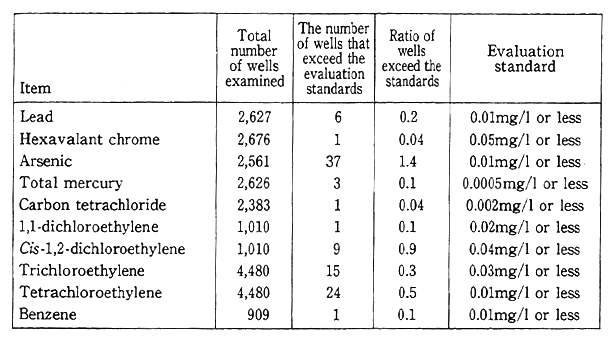
Notes: 1. Levels of evaluation standards are the same as the levels of the environ-mental Water standards for protection of human health. Due to the revision of the environmental quality standards made in March 1993, organic phosphorus was deleted and 13 substances including dichior-omethane, etc. were added (the evaluation standards were already set for trichioroethylene and tetrachioroethylene). Evaluation standards for lead and arsenic have been tightened.
2. Levels of substances other than those in the table were all below the levels of evaluation standards.
2. Measures to Control Groundwater Pollution
Once groundwater is polluted, it is very difficult to restore its original water quality. Therefore, it is important to take preventive measures before the pollution advances. The Environment Agency has established provisional guidelines concerning the controls on discharge of three substances including trichloroethylene, etc., and has been providing guidance to factories and other business establishments that are handling these substances since August 1984. The Ministry of Health and Welfare and the Ministry of International Trade and Industry have instructed the concerned industries, and the Ministry of Construction has been conducting investigations on groundwater.
However, the state of groundwater pollution by substances such as trichloroethylene has not improved. In 1989, the Water Pollution Control Law was partially revised in order to promote measures to prevent pollution caused by hazardous chemicals. With this revised law, measures such as the prohibition of the infiltration of water containing 11 hazardous substances such as trichloroethylene, etc., into the ground, the regular survey of the quality of groundwater by the governor of prefectures, etc. were taken in 1989 (Figure 8-5-1). In December 1993, the restrictions were tightened by adding another 13 substances including 1,1,1-trichloroethane, etc. to the designated hazardous chemicals.
Fig. 8-5-1 Groundwater Pollution Control System under Water Pollution Control Law
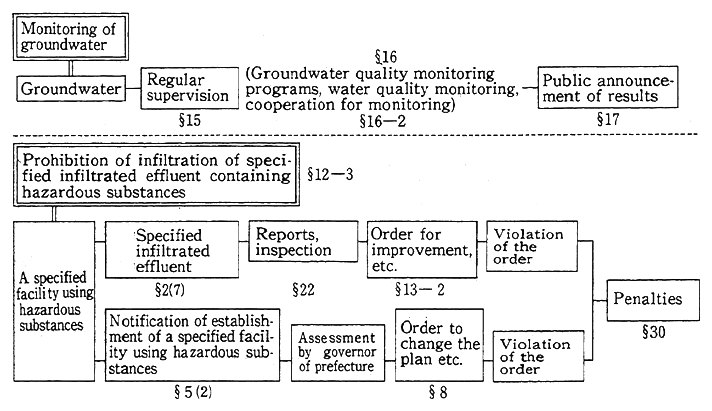
Financial aid has been provided by the Environment Agency toward the expenses incurred in the water quality surveys which are conducted in accordance with the groundwater quality measurement program formulated by the governor of prefecture.
In coping with groundwater pollution, it is essential to make efforts to prevent the pollution by strictly enforcing the Water Pollution Control Law, while studying the generation mechanism of the pollution and measures for cleaning up groundwater, and so on. In November 1994, the Environment Agency determined the "Provisional Guideline for the Surveys and Measures for Soil and Groundwater Pollution Concerning Organochiorine Compounds, etc." The guideline indicates the general procedures of surveys and measures in cases where ground-water pollution has been confirmed.. The agency also carries out research and investigations such as on-the-spot verification surveys of pollution restoration methods, etc., in order to further encourage the establishment of the related technologies.
Section6. Status of Marine Pollution and Measures Against It
1. Status of Marine Pollution
(1) Bays and harbors and their surrounding sea areas
The quality of water and the bottom sediments of Japanese bays and harbors and their surrounding areas are generally gradually improv-ing.. However, there still are many areas that are polluted by the effluent from factories-and workshops, and domestic effluent flowing in through rivers or directly. The occurrence of red tides are still a problem in the bay and harbor areas and their surrounding areas such as the Tokyo Bay, the Ise Bay, the Seto Inland Sea, etc.
(2) Adjacent seas of Japan
In order to understand the state of marine pollution as well as to help resolve the mechanism of marine pollution, the Environment Agency is carrying out the "Marine Pollution Monitoring in the Adja-cent Seas of Japan" which is to take measurements on general marine observation items and the levels of heavy metal contained in the sea water and the bottom sediments. The measurements are to be taken on the measurement points along certain measurement lines established in the sea areas. These lines are determined by drawing a line from a coast through the center of an area in which solidified sludge, etc. containing heavy metals, etc. which are specified in the Law for Prevention of Marine Pollution and Maritime Disasters (referred to as the "Marine Pollution and Disaster Prevention Law" hereafter) has been discharged (A Sea Area), while crossing currents that are flowing in the adjacent seas of Japan.
In order to obtain basic reference data to be used in the preserva-tion of the marine environment, the Maritime Safety Agency conducted an investigation to study the levels of marine pollution such as the oil content within the sea water and bottom sediments, PCBs, heavy metals, etc., in the waters surrounding Japan, A Sea Areas, major bay areas, etc. The result of the investigation indicate that there is no sign of advancing of pollution.
In the waters surrounding Japan, the drifting and drifting ashore of waste tar balls has been observed regularly. According to the result of the investigation conducted in 1994, the rate of drifting tar balls ashored remained at the same low level as the previous year, while drifting tar balls increased in the Nansei Islands area as compared to the previous year.
In an effort to understand the state of marine debris and to take appropriate measures against it, marine debris is observed visually on a regular basis. The result of the survey conducted in 1994 shows that 70% of the marine debris confirmed were petrochemical products such as Styrofoam, vinyl, etc. Most of them were found in the southern coast of Honshu same as the previous year.
Table 8-6-1 shows the number of occurrences of marine pollution within the water areas surrounding Japan in the past three years per the investigation conducted by the Maritime Safety Agency. The number of occurrences in 1994 was 732 cases, which is a decrease of 30 cases as compared to five years ago, and the lowest record since the statistics were first collected in 1971. In the results of 1994, the source that caused oil pollution most often was ships which caused 307 cases, the majority of the total occurrences; 121 cases of oil pollution were caused by careless handling; 88 cases by maritime disasters, and 79 cases of oil pollution were caused intentionally; 155 cases of pollution were caused other than by oil, mostly by intentional discharge of some substances from nearby lands.
In order to understand the general levels of marine pollutants, the Meteorological Agency conducts the Marine Background Pollution Observation in the water areas surrounding Japan as well as in the Northwest Pacific areas. According to this observation, levels of mercury and cadmium stay at the same levels every year, and the levels of waste tar balls have lowered since 1982. Levels of marine debris such as plastics, etc. remain the same levels in the open seas, but some high levels of it are observed in the Japanese waters, especially south and east of Honshu. There was no oil film observed in the waters surround-ing Japan in 1993, but one case was reported in 1994.
The Fisheries Agency has initiated marine pollution monitoring by implementing the Global Environment Monitoring Program Utilizing Fishing Boats, in which Japanese fishing boats operating in oceans all over the globe are used to monitor the marine environment.
Table 8-6-1 Changes in Numbers of Confirmed Marine Pollution by Sea Area
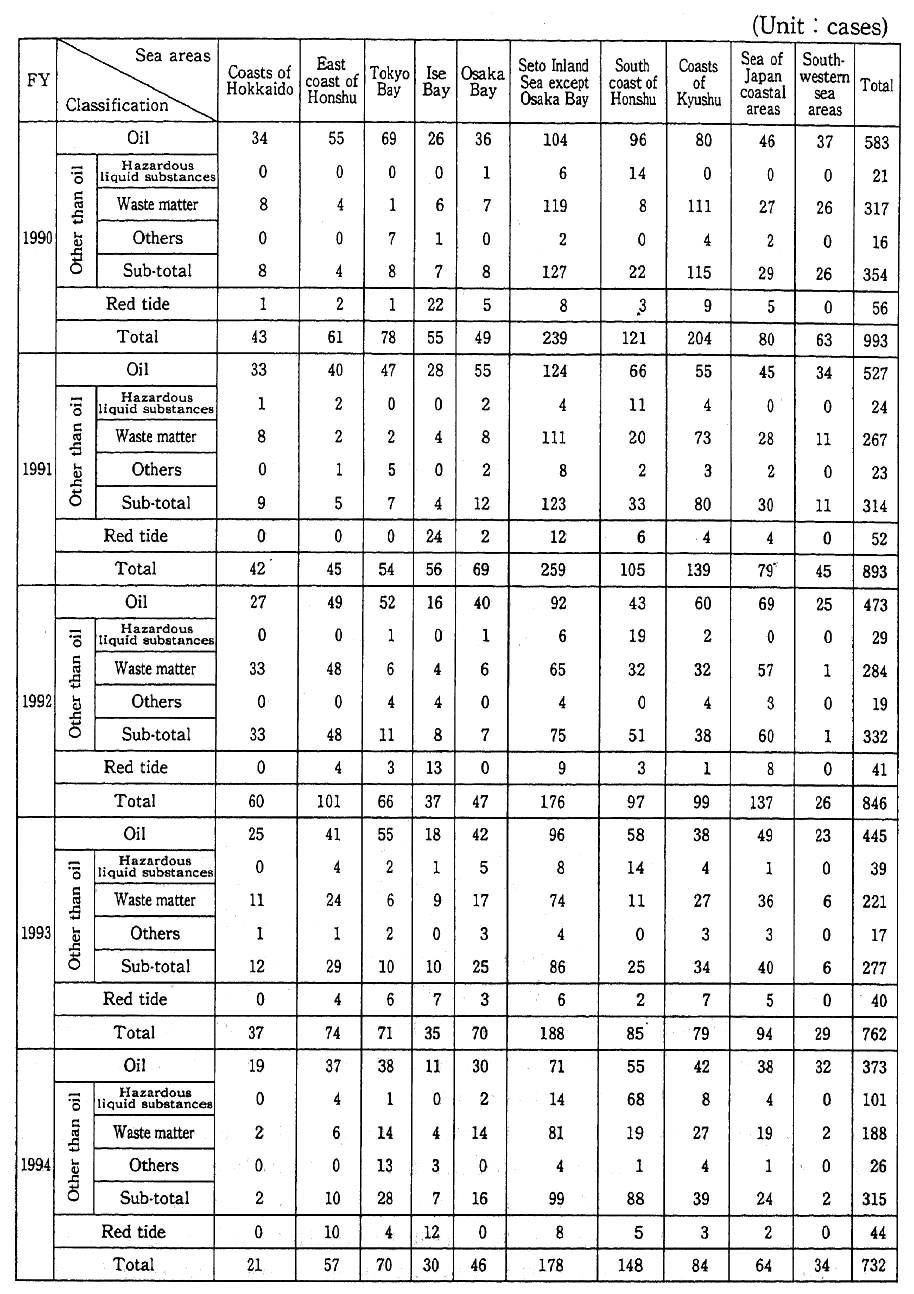
Note "Others" in the "Other than oil" category means industrial effluent, blue tides, etc.
2. Measures to Prevent Marine Pollution
(1) Preventive measures
1) Restrictions against ships
In conformity with the Marine Pollution and Disaster Prevention Law, restrictions on discharge of oil, hazardous substances, wastes, etc., restrictions on incineration, etc. have been enforced. Also, inspections to judge conformity to the engineering standards concerning the structure and facilities of ships, issuance of certificates of marine pollution prevention projects, etc. are carried out.
2) Assessment of unassessed liquid substances
In accordance with the enforcement of the restrictions on hazard-ous liquid substances, the Environment Agency has initiated the assess-ment of "unassessed liquid substances" since 1987. As of the end of March 1995, 127 substances have been assessed and the results were publicly announced.
3) Guidance for prevention of marine pollution
The Ministry of Transport and the Maritime Safety Agency jointly held seminars concerning the prevention of marine pollution, focusing on the restrictions on oil, hazardous liquid substances, and wastes per the Marine Pollution and Disaster Prevention Law, in order to make the restrictions known to everyone without exception and to raise the awareness of people concerning preservation of the marine environment. Guidance for the prevention of marine pollution were given specifically to foreign vessels that are not conforming to the standards agreed upon in treaties, etc.
The Maritime Safety Agency designated the week starting on Environment Day as "Marine Pollution Prevention Week," and makes visits to ships to give intensive guidance. The agency also strove to advance the concept of marine pollution prevention and to make marine pollution-related laws thoroughly known to the people concerned, utiliz-ing the marine pollution monitoring system.
4) Improvement of waste oil treatment facilities
Among all waste oil treatment facilities that process waste oil from vessels, improvement was made to the public facilities. As of December 1994, there are 132 waste oil treatment facilities in 81 ports including private ones. Fifty facilities in 36 ports among these process waste light oil.
(2) Improvement of systems to control discharged oil, etc.
In order to cope with oil spill accidents, the Maritime Safety Agency has established an around-the-clock mobilization system of patrol boats and airplanes, provided their boats and airplanes with oil spill controlling equipment, and given guidance to ship owners, etc. concerning the furnishing of oil spill controlling equipment. The agency also provided guidance and training to the local councils on measures to cope with disasters caused by spilled oil, which is an organization consisting of public and private personnel and the Marine Disaster Prevention Centers, which are central organizations privately operated to cope with marine disasters located in ports and harbors or sea areas where there are petrochemical complexes.
Additionally, drills on the supposition of a massive oil spill accident were condtucted jointly by public and private organizations nationwide.
(3) Measures for environmental conservation of ports, harbors, and surrounding sea areas
In order to conserve the environment of port, harbors, and surrounding sea areas, projects for the prevention of pollution in ports and harbors such as dredging of organic sludge, etc. in 13 ports including the Tokyo Port and the Osaka Port were conducted in the fiscal year 1994. As part of the project to improve the environment of ports and harbors, shore protection projects by reclamation with waste were carried out in 36 ports and one bay including the Yokkaichi Port, the Kita-Kyushu Port, etc. An engineering investigation for the develop-ment of a large waste disposal facility was conducted in the Tokyo Bay.
Collection of trash and oil was carried out in sea areas outside of ports and harbors. In order to improve the environment of enclosed sea areas with substantial sludge accumulated, the marine environment creation projects (overlaying sand and development of seashores) were carried out in two sea areas including the Seto Inland Sea, etc. and eight ports.
(4) Research and development of marine pollution prevention technologies
In an effort to promote the prevention of marine pollution, the Ministry of Transport carried out research and development of technol-ogies to prevent discharge of oil from vessels, and purification methods of exhaust gas.
Research and development was conducted on the technologies to purify water such as treatment with gravel, exposing to air, induction of water, etc.
The Maritime Safety Agency conducted research on high-level identification methods of small amounts of lubricant contained in oil released in the sea. The agency also conducted research and develop-ment in the Ise Bay, one of the enclosed sea areas, to understand the movement of sea water and the circulation of substances which affect the occurrence of red tides, etc. The research and development of a model for the movement of sea water, and a model showing the stratifi-cation and alteration of water temperatures, salt content, etc. were carried out.
In an attempt to reduce the impact to the marine environment caused by released fishing equipment, the Fisheries Agency executed the development of fishing equipment made of biodegradable plastic.
3. Status of Controls of Marine Pollution
(1) The status of controls
In an effort to sweep away marine pollution crimes, the Maritime Safety Agency enforces the monitoring and controlling of marine pollution in the Japanese waters. Especially in areas with heavy marine traffic where marine pollution can occur easily, such as the Tokyo Bay, the Inland Sea of Japan, etc., and areas which are routes of oil tankers, the monitoring and controlling are strengthened with patrol boats carrying helicopters and aircraft stationed intensively. Concentrated controls were enforced nationwide for a limited time.
(2) The status of legal procedure of marine pollution crimes
Table 8-6-2 shows the number of cases of violation of the marine pollution related laws, which were sent to the authorities by the Maritime Safety Agency within the past three years. Out of 1,130 cases of 1994, the number of offenses that directly contribute to the marine pollution such as discharge of oil, hazardous liquid substances, wastes, etc. was 1,047, which accounted for 93% of the total offenses.
Table 8-6-2 Changes in Numbers of Violations of Laws concerning Marine Pollution that have been sent to Authorities
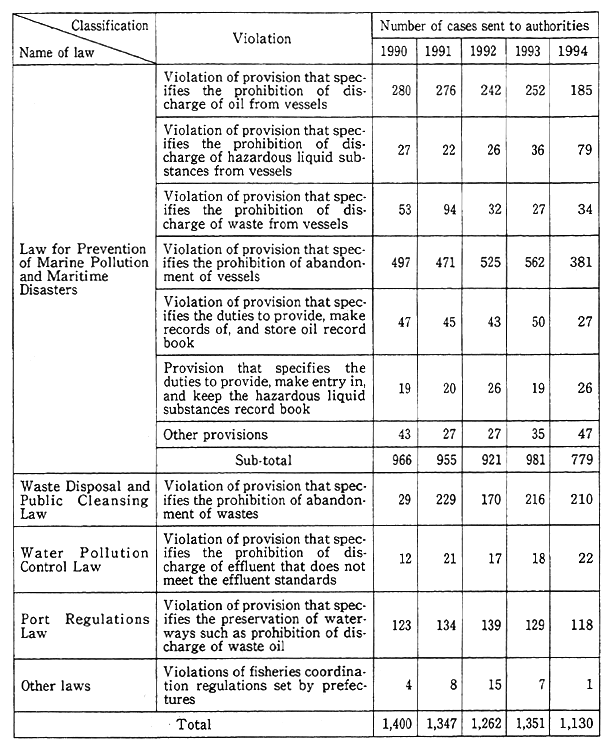
4. Improvement of the Reparation and Compensation System of Damage by Oil Pollution
Since damages caused by oil spill accidents of tankers can cost a tremendous amount of money, two treaties have been concluded in order to enhance the reparation and compensation system. These treaties are the International Convention on Civil Liability for Oil Pollution Damage and the International Convention on the Establishment of An Interna-tional Fund for Compensation for Oil Pollution Damage (a supplementa-tion to the International Convention on Civil Liability for Oil Pollution Damage established in 1969). The Law for the Reparation and Compen-sation of Damage by Oil Pollution, the law modified from these interna-tional conventions, was established in 1975. Concerning the damages by oil pollution caused by tankers, the law specifies that (i) strict liabil-ity should be imposed upon the owner of the vessel; (ii) the limit of the amount of liability of the ship owner should be set; (iii) for tankers carrying oil of 2,000t or more, insurance that covers the limit liability amount should be mandatory; and (iv) when sufficient reparation can not be provided to the victims of oil pollution by the ship owner, the limited amount of compensation should be provided by the international fund.
Four agreements on revision of these conventions have been adopted, which specify the raising the limit of the amount of liability of the ship owner and the compensation limit by the international fund. In accordance with this revision, the Law for the Reparation and Compen-sation of Damage by Oil Pollution was revised in 1994, and the Govern-ment concluded these agreements on revision. Various countries are in the process of concluding the agreements and the early effectuation of the agreements is expected.
Among all damages to fisheries by oil pollution, cases in which the party who caused the damage is unknown account for the great majority.. For these cases, financial aid was provided for the relief program (improvement in payment of relief money and oil pollution control fund) operated by the Fund for Oil Pollution Damage to Fishing Grounds toward the victims. In the fiscal year 1993, relief was provided in 17 cases with the total relief amount of 22,230,000 yen.
Chapter9. Present Status of Other Public Hazards and Countermeasures
Section1. Present Status of Waste Management
1. Present Status of Waste Disposal
(1) Treatment of General Waste
General waste is treated according to the plans set by municipal-ities. The status of human waste treatment is shown in Table 9-1-1. In 1991, a total of 100,719 kiloliters of human waste and sludge from combined waste water treatment equipment were generated per day. Of this, 88% was treated by sewage treatment facilities and sewerage systems.
As shown in the Figure 9-1-1, approximately seven million septic tanks are now installed nationally, providing the benefit of a water flushing system to roughly one fourth of the total population, or 34.33 million people.
Table 9-1-2 shows the status of garbage treatment. In 1991, daily production of garbage reached approximately 138,708 tons showing an increase of 0.6% compared to the previous year. Of this, 83% was reduced through incineration or crushing.
(2) Treatment of Industrial Waste
Table 9-1-3 shows the amount of industrial waste produced nationally. Table 9-1-4 shows the status of industrial waste management facilities in 1992. The number of permits issued to companies treating industrial waste is growing annually. As of April 1992, the number of permits stood at 75,305..
2. Measures for Waste Treatment
(1) Issues and countermeasures against wastes
Due to increased economic activities and changes in people lifestyles in recent years, there has been an increase of waste, in amount as well as in variety. As the result, securing disposal sites is becoming increasingly difficult, and inadequate waste treatment caused by illegal dumping has now become a serious social problem.
Table 9-1-1 Status of Night Soil Treatment Conditions
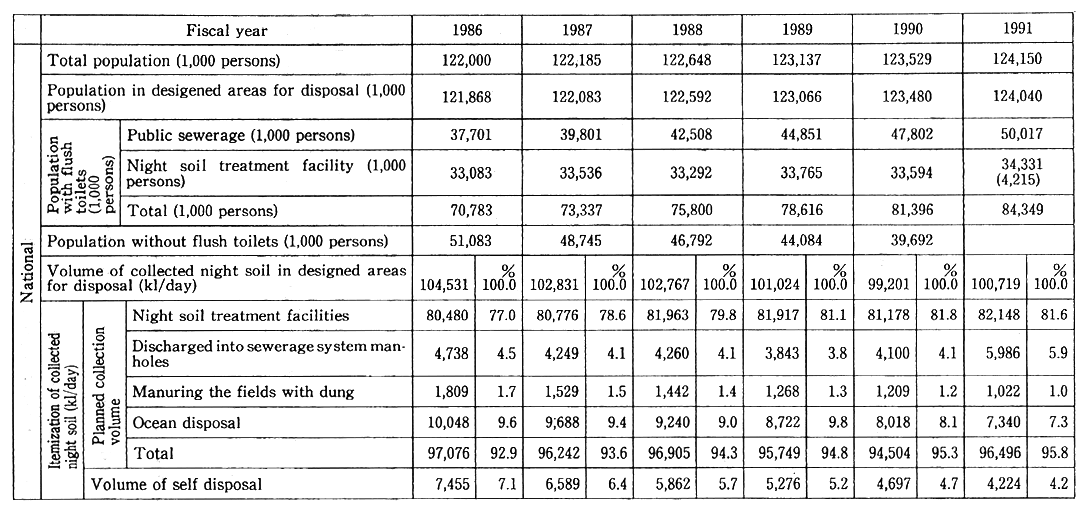
Notes: 1. Aggregate volume of collected night soil=volum of collected night soil+ sludge generated in night soil treatment facility.
2. The figures are rounded therefore the totals do not always equal the sums of the itemizations.
3. In the total population figures foreigners in some municipalities and villages are included.
4. The number in parentheses in the line for "night soil treatment facility" represents combined collection treatment population (i.e., combined collection night soil treatment facility and community plant population).
Fig. 9-1-1 Number of Night Soil Treatment Facilities (national)
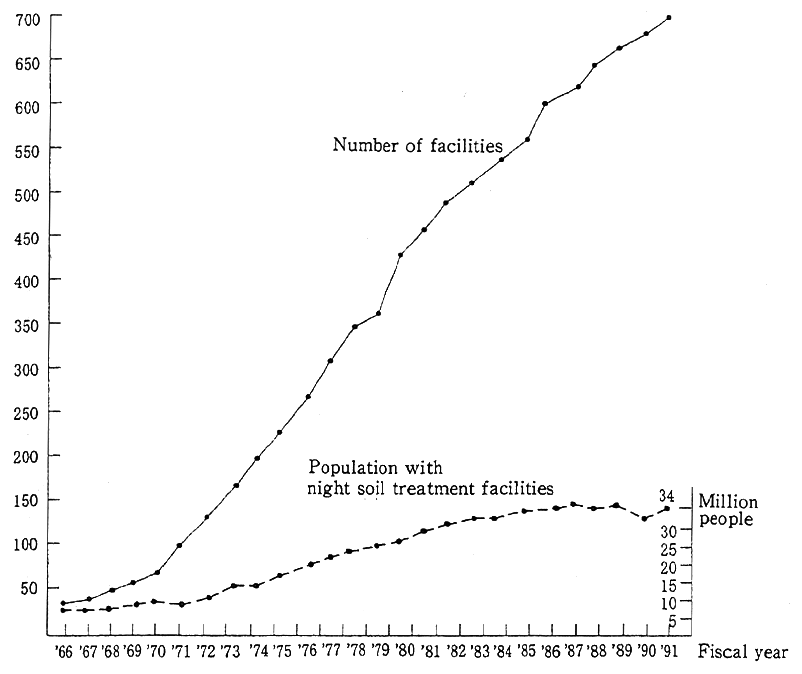
To deal with this situation, a three-prong policy emphasizing (i) reduction and recycling of waste, (ii) securing appropriate waste treat-ment methods, and (iii) proper preparation of treatment facilities has been promoted based on the Waste Disposal and Public Cleansing Law. Also promoted are improved utilization of waste treatment centers and improvement of the specialized facilities based on the Law for the Improvement of Specialized Facilities for Industrial Waste Disposal.
Further, the environmental quality standards for water pollution was revised in April of 1993. In September 1994, a partial revision was made in the Ordinance Concerning the Waste Disposal and Public Cleansing, and in the Ordinance Concerning the Prevention of Marine Pollution and Maritime Disaster. These revised ordinances added 13 chemicals and other materials, including dichlorornethane, to the list of substances contained in industrial waste requiring special treatment, and established the standard for the final disposal of these industrial waste. The revised ordinance also requires that shredder-dust (the by-product of crushing automobiles) be treated in managed treatment facilities instead of regular treatment facilities, and strengthened the regulations on waste that is harmful to the environment.
Table 9-1-2 Status of Waste Disposal Conditions (national)
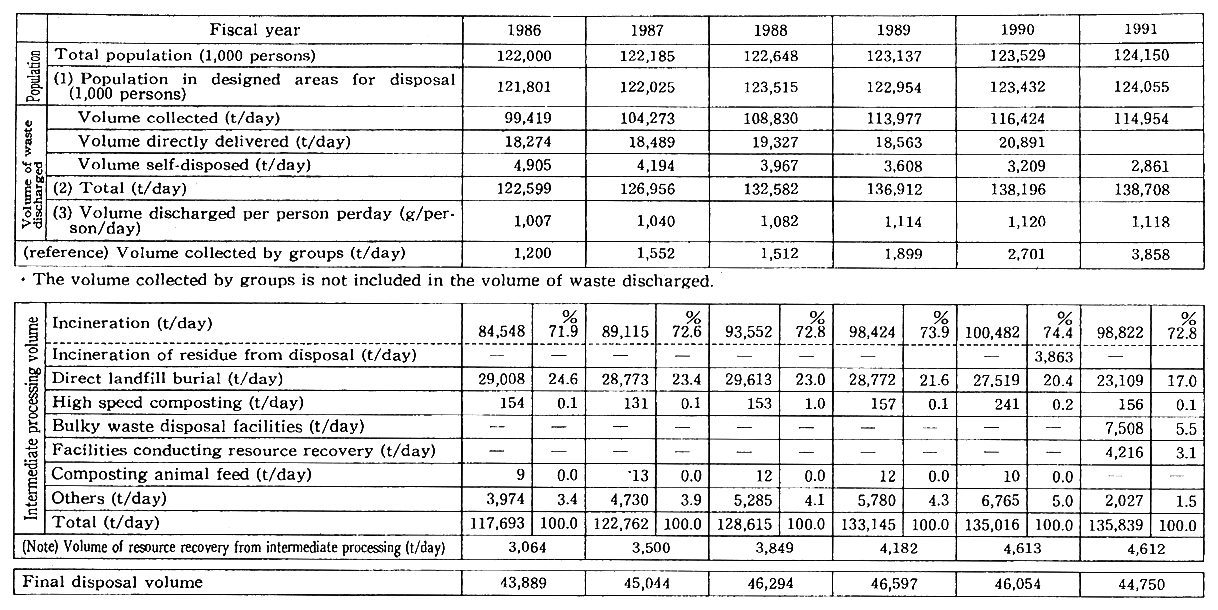
Note: (3)=(2)/(1)
Collection by groups include the volume collected by community associations with public participation, local P.T.A and other such organizations.
The volume of resource recovery from intermediate processing is the volume of iron, aluminum and other materials recovered after the disposal of nutural resource waste and bulky waste.
The figures have been rounded so the totals do not always equal the sums of the itemizations.
In the total population figures foreigners in some municipalities and villages are included.
Table 9-1-3 Amounts of Industrial Wastes Generated
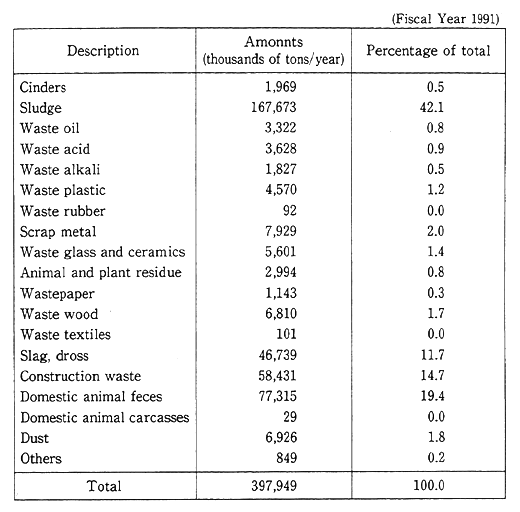
Note : Data according to the Ministry of Health and Welfare
(2) Measures for general waste
To manage increased general wastes, facilities for general waste such as garbage disposal facilities, sewage treatment facilities and landfills have been upgraded and added through supplementary funding totaling 128.7 billion yen (excluding non-supplementary repayment) in 1994.
Table 9-1-4 Industrial Waste Disposal Facility Installations
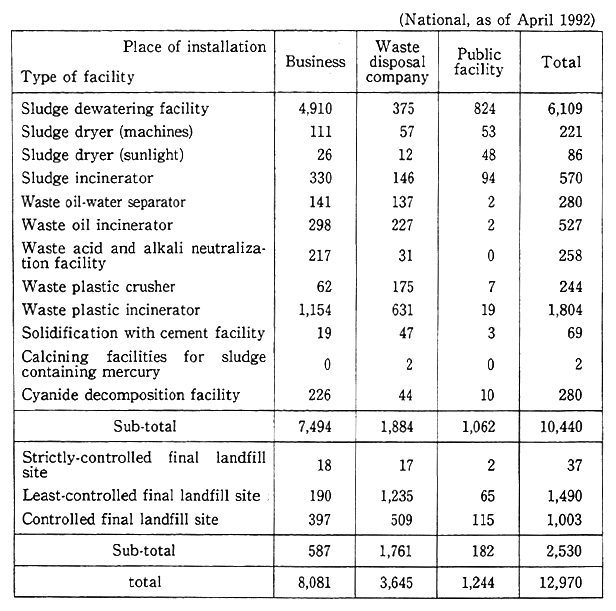
Notes :1. Data according to the Ministry of Health and Welfare.
2. Facilities that reported in accordance with Section 15 Paragraph 1 of Waste Management and Pubic Cleansing Law.
3. Final landfill sites that 'nix both industrial waste and general waste are included in controlled landfill sites.
4. Public facilities are local authority and public corporations that conduct water works, sewerage works and industrial water works.
To establish a comfortable living environment in the face of increased wastes, both in amount and in variety, the idea of the "zero garbage society" was developed. Beginning in 1994, the waste manage-ment policy has changed from. that of "burn and bury" to "waste management by recycling," where the waste is recycled as much as possible and the rest incinerated while utilizing the heat produced in the process.
Further, to promote waste reduction and recycling, a report was prepared in October 1994 by the Expert Committee of Waste Reduction and Recycling under the Council of the Living Environment of the Ministry of Health and Welfare. Another report was also produced for the same purpose in July of that same year by the Committee of the Waste Treatment and Resource Regeneration, under the Industrial Structure Council of the Ministry of International Trade and Industry.
(3) Promotion and propagation of combined waste water treatment equipment
The combined waste water treatment equipment is drawing attention as an effective tool to counter waste water problems. The support for the combined waste water treatment equipment comes from the Project for the Development of the Combined Waste Water Treat-ment Plant, and the Project for the Waste Water Treatment for the Designated Area. The national budget for supplementary funding for these projects has increased to 16.6 billion yen including the amended budget amount. The number of local governments that implemented these projects has increased from 1,663 to 1,838 in 1993. Beginning 1989, a local subsidy tax measure has been implemented for the local govern-ment to meet the expenses for such projects.
The report by the Expert Committee for the Waste Water Treatment Equipment of the Living Environment Council, "Way to Administer the Waste Water Treatment Equipment in the Future," advocates following three points in the propagation of combined waste water treatment equipments :1) site preparation based on existing communities, 2) establishment of a management administration organi-zation for appropriate and effective system management and mainte-nance, and 3) a systematic response system for securing the water resource and water quality. The Law Concerning the Promotion for the Implementation of the Project to Secure Water Resources and Water Quality was promulgated in March 1994. This law allows local govern-ments that administer water treatment plants to provide advice or counsel to the persons who produce waste water and allow the national government to provide subsidies for such projects.
This law also established the Specified Area Waste Water Treatment Project within the designated area under the plan of local governments, where the local governments develop and operate the waste water treatment system.
Further, this law promotes the development of water treatment plans by the local governments to treat the waste water appropriately, and as a result, make a systematic improvement in community plants and combined waste water treatment equipments according to such plans.
(4) Measures for industrial wastes
In the area of industrial wastes, securing treatment sites that would accept such wastes is becoming increasingly difficult due to the increased amount and variety of wastes. Inappropriate treatment of illegally disposed waste is also becoming a serious social problem. Because of this, the Ministry of Health and Welfare is facilitating the development of treatment facilities based on public interest within the framework of the "Responsibility of the Waste Producer Rule' As a result, the Ministry established the waste treatment centers in Iwate, Ohita, Nagano, Ehime and Kagawa Prefectures and designated Niigata and Kochi Prefectures for establishing centers in 1994.
Encouraged by the Law for Improvement of Specialized Facilities for Industrial Waste Disposal, many interventions have been implement-ed to improve the appropriate treatment of industrial wastes. In 1994, promotional activities such as modernization of industrial waste treat-ment facilities, loan guarantees for facility improvement, and support for business startup have been implemented by the Industrial Waste Management Enterprise Development Foundation.
In the area of rehabilitating illegal dumping grounds, the issues concerning administrative measures, compensation responsibilities in civil cases, and the issue of bearing expenses for such activities were reviewed and. summarized.
For the purpose of information gathering, surveys were conduct-ed on the current status of industrial waste treatment, the status of administrative interventions and the progress in facility development.
As for administrative interventions, in 1991, there were 56,914 incidents of on-site inspections, 12,140 incidents of information collec-tions, 72 incidents of cancellations or temporary suspensions of permit and 17 administrative orders for facility improvements or adjustments.
The Ministry of International Trade and Industry conducted a variety of experimental studies and research necessary for future planning of industrial waste treatment and recycling of resources. The Ministry also provided support for an experimental treatment plant developed by the Clean Japan Center, and to other enterprises dealing with the recycling of resources, such as studies on the status on scat-tered wastes.
Due to the expansion of funding for public construction, the Ministry of Construction implemented comprehensive measures to cope with the expected increase of construction wastes. The purposes of these measures are reducing waste production, and recycling through the treatment of wastes. These measures include the development of a locally appropriate Plan for the Treatment of Construction By-Products (called "Recycl Plan 21"), and guidance and counseling activities for the material buyers and contractors dictated in the Outline for the Promo-tion of Appropriate Treatment of Construction By-Products issued on January 1993.
The Ministry of Agriculture, Forestry and Fisheries provided support for research and testing of technology development for appro-priate disposal of agricultural plastic products, and provided support for, the establishment of plastic treatment facilities by the farmers' associa-tions.
The Fishery Agency assisted the development of the waste management plan relating to the FRP fishing boats and fishing nets.
(5) Implemeatation of the Law for the Promotion of Utilization of Recyclable Resources
There has been an increase in recyclable wastes due to the recent economic expansion and accompanying increase in productions and consumption of goods as well as the changes of lifestyle in this country. However, many of the recyclable materials have been discarded without being used. It is also widely recognized that the increasing waste is threatening the environment that is the base of our future prosperity.
Considering these factors, the Law for the Promotion of Utiliza-tion of Recyclable Resources has been enacted in October in 1991, to promote the effective use of limited resources, to suppress waste pro-duction, and to safeguard the environment. This law set the basic directions for the planned and comprehensive use of recyclable mate-rials. Under this law, inter-agency measures were established to pro-mote the use of recyclable materials in specially designated industries (paper mills, glass container producers, construction) ; the use of struc-ture and materials selections conducive to the use of recyclable mate-rials for Category I products (automobiles, air conditioners, televisions, washing machines, refrigerators and twenty electrically operated items using nickel-cadmium cells); the labeling of Category II products (soft drink containers made of aluminum or steel ; PET bottles and nickel-cadmium cells) for the ease of separate collections; and the use of specified by-products (iron and steel slug, coal ash, soil and sand, cement blocks, asphalt-concrete blocks, lumber) as recyclable materials.
(6) Promotion of cross-jurisdictional waste treatment facility development
In metropolitan area, the Ministry of Health and Welfare and the Ministry of Transport have been advocating a plan that uses land-fill for the establishment of cross-jurisdictional waste treatment facilities (Phoenix Plan) to enhance the chance of securing the site for the final disposal of cross-jurisdictional wastes. In the Osaka Bay area, the Osaka Bay Cross-Jurisdictional Litter Environmental Development Center has continued the construction of a cross-jurisdictional treat-ment facility and has taken the responsibility of accepting wastes and operating landfill. The center also conducted the survey for the next planning phase.
In regard to the Tokyo Bay area, the Ministry of Health and Welfare and the Ministry of Transport have finalized the basic design of the Tokyo Bay Phoenix Plan and have presented the plan for the cross-jurisdictional waste treatment plant to the related local public bodies, which are still studying the plan. The Ministry of Health and V,Telfare is continuing the survey on cross-jurisdictional waste treatment plant development in the Tokyo Bay area. It also conducted a basic survey and research in the Chugoku (central Japan) area and Hokubu-ihyushu (northern Kyushu Island) area.
(7) Others
In November 1989, the Environment Agency and the Ministry of Health and Welfare co-authored the directives outlining the basic directions for the management of designated sites for final waste disposal. The directives were issued in order to prevent pollution com-ing from the designated final waste disposal site and to plan the appro-priate use of that site. The Environment Agency also conducted the study to improve the technology for preventing groundwater contamina-tion at designated sites for final waste disposal. This is a part of studies to improve the effectiveness of site management. The Agency also identified and evaluated technologies considered to be effective in protecting the environment from among technologies currently used at the final disposal sites, and conducted research to develop and dissemi-nate the higher technologies. Further, it conducted various research studies and promotional activities encouraging recycling to reduce waste generation and to lessen the stress to the environment. For recycling of wastes, no quality standard had been established to pre-serve the environment. Because of this, the agency conducted a study to set the quality standard for environmental preservation.
The Ministry of Transport provided support totaling 33.5 billion yen (including national expenditure of 8.7 billion yen) to develop landfill water fronts for 36 harbors and one bay as the measures for waste treatment in harbors in 1994. The Ministry also provided the support for the spilled oil treatment facilities and conducted garbage and spilled oil collections in the sea. Further, the Ministry began a project that uses ground soil produced in the process of construction in the metropolitan area as the resources for building harbors in other areas (Super Phoenix Project) and began soil transfer to Hiroshima and Kochi harbors in 1994.
The Ministry of Construction began using sediment produced during sewage treatment for farmland soil, while paying careful atten-tion to environmental safety. The Ministry also began recycling of construction materials, and started actively using recycled materials in the construction of sewerage systems.
The Ministry of Health and Welfare engaged activities to system-atically develop widearea recycling facilities in the metropolitan area to utilize incineration ash in order to prolong the life of the final waste disposal site.
Section2. Status of Ground Environment and Preservation Measures
1. Status of Ground Subsidence
Ground Subsidence has a long history in Japan, first receiving attention in the early Taisho Period (1912-1926). Annual changes in ground subsidence in typical areas are shown in Figure 9-2-1.
The principal cause of ground subsidence is excessive pumping-up of groundwater. Uses of this water pumped from the ground re not confined to industry and construction but also include a diverse range of other uses, such as for drinking water, agriculture, aqua culture and for melting snow, as shown in Table 9-24.
Through fiscal 1993, 62 districts in 37 of Japan's 47 prefectures had been recognized as ground subsidence areas. These are shown in Figure 9-2-2.
Fig. 9-2-1 Changes of Aggregated Amount of Ground Subsi-dence in Representative Ground Subsidence Areas
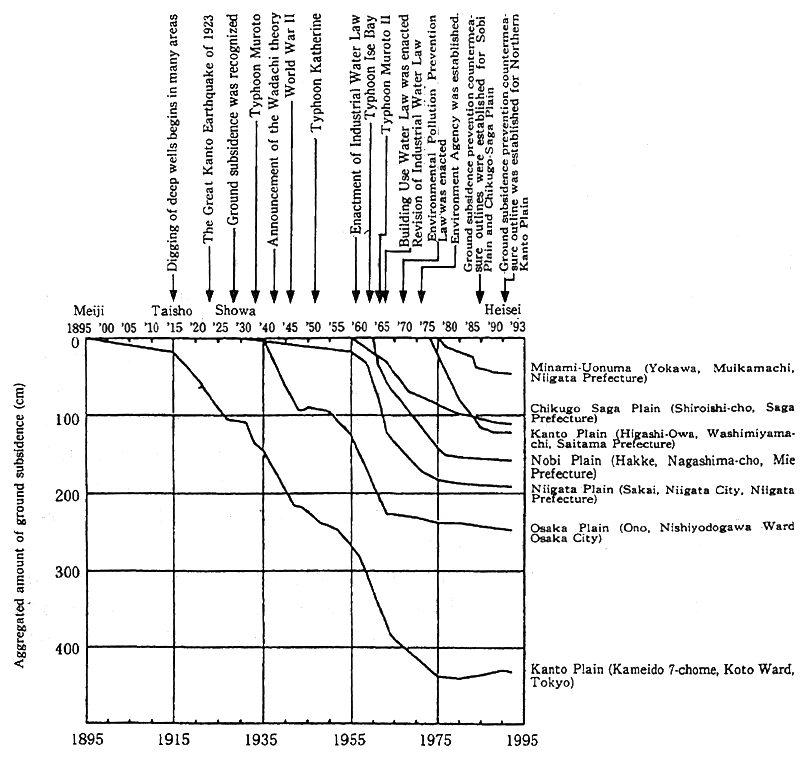
The principal characteristics of ground subsidence in Japan in recent year are as follows :
(1) Surveys of areas affected by ground subsidence in fiscal 1993 show that the number of areas that had subsided 2 cm or more had remarkably decreased in comparison with 1992. Figure 9-2-2 suggests, the number of areas affected by ground subsidence appears to be decreasing in the long term
The area where the greatest degree of ground subsidence was observed in fiscal 1993 was Minami-Uonuma in Niigata Prefecture where subsidence of 7.7 cm was recorded, the same as in fiscal 1991 and in 1992. Except Minami-Uonuma area, there was no area where subsi-dence of more than 4 cm was recorded.
Table 9-2-1 Use of Underground Water in Japan
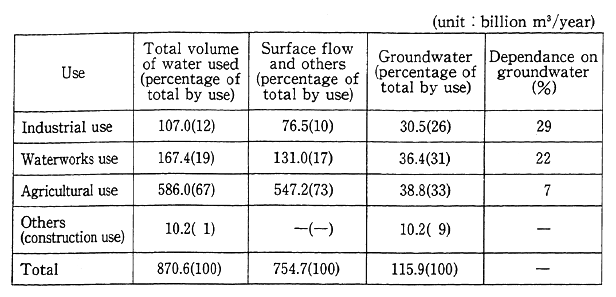
Note:1. Industrial use was computed according to the fiscal year 1994 "Census of Manufactures" compiled by the Ministry of International Trade and Industry (fiscal year 1992 survey) with calculations based on 300 days of operations. Total volume of water for industrial use excludes recirculat-ed water. Here, Groundwater is collected from well (i.e., water collected from shallow wells, deep wells and springs).
2. Waterworks use was computed according to the fiscal year 1992 "Water Service Statistics" compiled by the Ministry of Health and Welfare (fiscal year 1992 survey). (Sum of waterworks business and water-works supply.) Here, groundwater is collected from well (shallow and deep well water).
3. Volume of agricultural use water is according to the fiscal year 1994 "Japan's Water Resources". Agricultural use of groundwater is according to the fiscal year 1991 Ministry of Agriculture and Forestry "Study on the Agricultural Usage of Ground Water" (actual water use between Septem-ber 1984 and August 1985). Here, groundwater is collected from deep wells, shallow wells, water collection ditches and springs.
4. Construction use is according to the "Study on the Conditions of Volume of Groundwater Pumped" conducted by the Environment Agency (fiscal years 1971 through 1993) and studies conducted by local governments on actual groundwater use.